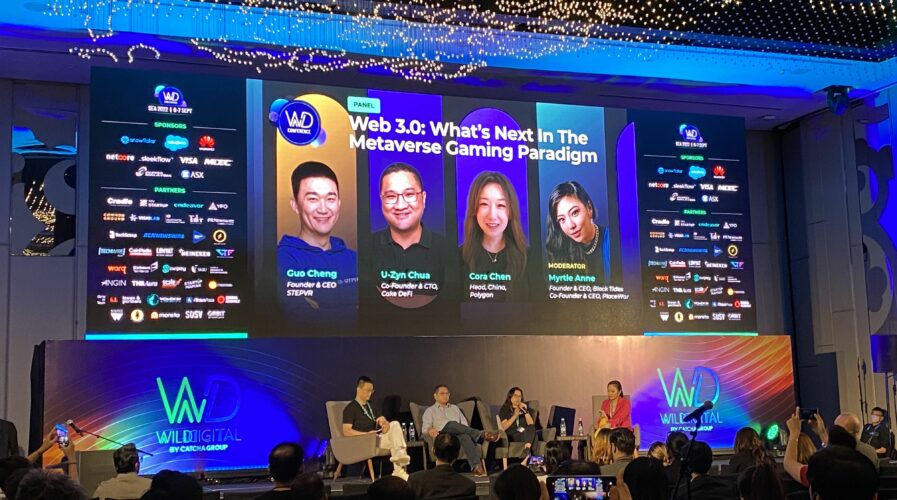
Cora Chen, Head of China at Polygon, Guo Cheng, Founder & CEO at StepVR, and U-Zyn Chua, Co-Founder & CTO at Cake DeFi, talk about the metaverse gaming paradigm of the future.
What is the future looking like for the metaverse gaming paradigm in Web3?
- The user-friendliness of getting people onto the metaverse is going to be really key to driving the adoption of Web3 innovations
- StepVR is building a “Ready Player One” machine to enter the metaverse
The evolution of the metaverse is thrilling yet complex, offering answers that have an effect on people’s day-to-day lives in this brand-new digital world. Especially now that the gaming industry, the metaverse, and blockchain, which are the way of the future, are all emerging.
Southeast Asia’s metaverse opportunities indicate that this industry will keep developing and prospering over the next few years. A panel of experts, including Cora Chen, Head of China at Polygon, Guo Cheng, Founder & CEO at StepVR, and U-Zyn Chua, Co-Founder & CTO at Cake DeFi, shared their perspectives on how the region is experiencing a surge in GameFi with entrepreneurs benefiting from financing, developing Web3 gaming metaverse, and challenges that this new world will be looking at, at Wild Digital Southeast Asia in Kuala Lumpur recently.
“I think the user-friendliness of getting people onto the metaverse, is going to be really key to driving adoption of Web3 innovations. Firstly, I think for Web3, we’re at this stage where we’re seeing Web3 innovations coming up in different areas in cyberspace along with the metaverse,” said Chua.
The adoption of cryptocurrencies and NFTs, the rise of DAOs, and the various advancements in blockchain-based infrastructure and storage are all contributing to the rapid adoption of the new Web3 computing paradigm.
In fact, approximately 70% of people in Southeast Asia used at least one technology related to the metaverse last year. As more industries begin to adopt these innovative Web3 technologies for realistic virtual 3D experiences, this number will continue to rise.
Metaverse gaming: Defining sustainability for play-to-earn games
When it comes to gaming, players now have the option to claim actual ownership of their in-game assets, which play-to-earn (P2E) game producers mint as NFTs on the blockchain, thanks to NFT-driven P2E games, also referred to as “crypto games.”
P2E was therefore always regarded as an unsustainable model. Chua asserts that many users who engage in P2E game activity do it primarily for financial gain as opposed to the “fun” aspect.
“A lot of the game is funded by inflation. So, the more tokens being generated from that game, it allows users to sell the token to make money. So, you’re not really enjoying the game; you’re just farming more and more tokens to earn money – [making it unsustainable],” said Chua.
Gaming is a major application for StepVR, therefore if they provide the P2E infrastructure, the game must be playable. And the metaverse is where the only revolution will take place.
“From our expertise, we built a Counter Strike-like game before, and it was easy to build. We only invest six people to build the game for three weeks. Last year, we hosted more than 700,000 players in that game last year, and 70% of them play more than once. Looking at the comeback rate, more than 70% of them buy a loyalty card to play multiple times. So, if we can build a similar infrastructure, which is really playable, and they can earn something – that’s how play-to-earn should be,” explained Cheng on driving sustainability for P2E games.
Driving more people into the Web3
For Web2 users to transition to Web3, there are certain criteria. The mode of payment comes first. Chen claims that setting up a cryptocurrency wallet in order to buy tokens or move cross-chain assets is difficult for Web2 users.
“[However, even though it’s complicated], a crypto wallet is more convenient. In Web2, you guys have to do registration in different platforms again, and again every single time. You’re going to type your credit card information continuously. In the Web3 world, you just use your crypto wallet, you can go to any decentralized platform, play a game, purchase NFTs,” explained Chen.
Despite how convenient this is, she claims that living in the present day in the digital age is difficult for people to change their habits. As a result, she suggests that people proceed gradually and piecemeal.
She claims that several NFT marketplaces in the Polygon ecosystem offer credit card payments in response to that challenge. Additionally, Polygon is working with Stripe, Alchemy Pay, and additional payment platforms to lower Web2 users’ criteria for Web3 access.
Adding on to this, Cheng also shared that “StepVR is building a “Ready Player One” machine by which you can use it to enter the metaverse. We have been working on these for the last nine years and we’re building it based on the five senses, sight, touch, smell, taste and hearing,” said Cheng.
The goal of StepVR, according to Cheng, is to create an immersive VR experience for every home. He revealed that the company will release the $2000 Gates01 commercial version, an open-air box that will enable people to enter a virtual world and experience it in a way that a simple headset could not.
READ MORE
- 3 Steps to Successfully Automate Copilot for Microsoft 365 Implementation
- Trustworthy AI – the Promise of Enterprise-Friendly Generative Machine Learning with Dell and NVIDIA
- Strategies for Democratizing GenAI
- The criticality of endpoint management in cybersecurity and operations
- Ethical AI: The renewed importance of safeguarding data and customer privacy in Generative AI applications
